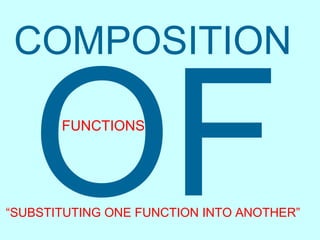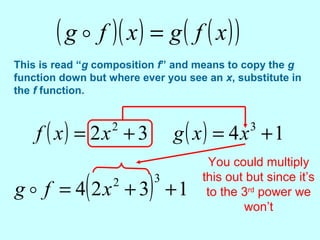Operations on Functions
- 2. The sum f + g ( f + g )( x ) = f ( x ) + g ( x ) This just says that to find the sum of two functions, add them together. You should simplify by finding like terms. f ( x) = 2x + 3 g( x) = 4x + 1 2 3 f + g = 2x + 3 + 4x +1 2 3 = 4x + 2x + 4 3 2 Combine like terms & put in descending order
- 3. The difference f - g ( f − g )( x ) = f ( x ) − g ( x ) To find the difference between two functions, subtract the first from the second. CAUTION: Make sure you distribute the – to each term of the second function. You should simplify by combining like terms. f ( x) = 2x + 3 2 f − g = 2x 2 + 3 − (4x g( x) = 4x + 1 3 3 + 1) Distribute negative 2 = 2 x + 3 − 4 x − 1 = −4 x + 2 x + 2 2 3 3
- 4. The product f • g ( f ⋅ g )( x ) = f ( x ) ⋅ g ( x ) To find the product of two functions, put parenthesis around them and multiply each term from the first function to each term of the second function. f ( x) = 2x + 3 g( x) = 4x + 1 2 ( 3 )( ) f ⋅ g = 2x + 3 4x +1 2 3 = 8 x + 2 x + 12 x + 3 5 2 3 FOIL Good idea to put in descending order but not required.
- 5. The quotient f /g f f ( x) ( x ) = g g ( x) To find the quotient of two functions, put the first one over the second. f ( x) = 2x + 3 2 f 2x + 3 = 3 g 4x +1 2 g( x) = 4x + 1 3 Nothing more you could do here. (If you can reduce these you should).
- 6. So the first 4 operations on functions are pretty straight forward. The rules for the domain of functions would apply to these combinations of functions as well. The domain of the sum, difference or product would be the numbers x in the domains of both f and g. For the quotient, you would also need to exclude any numbers x that would make the resulting denominator 0.
- 7. COMPOSITION OF FUNCTIONS “SUBSTITUTING ONE FUNCTION INTO ANOTHER”
- 8. The Composition Function ( f g )( x ) = f ( g ( x ) ) This is read “f composition g” and means to copy the f function down but where ever you see an x, substitute in the g function. f ( x) = 2x + 3 g( x) = 4x + 1 2 ( 3 ) 2 f g = 2 4x +1 + 3 3 FOIL first and then distribute the 2 6 3 = 32 x + 16 x + 2 + 3 = 32 x + 16 x + 5 6 3
- 9. ( g f )( x ) = g ( f ( x ) ) This is read “g composition f” and means to copy the g function down but where ever you see an x, substitute in the f function. f ( x) = 2x + 3 g( x) = 4x + 1 2 ( 3 ) 3 g f = 4 2x + 3 +1 2 You could multiply this out but since it’s to the 3rd power we won’t
- 10. ( f f )( x ) = f ( f ( x ) ) This is read “f composition f” and means to copy the f function down but where ever you see an x, substitute in the f function. (So sub the function into itself). f ( x) = 2x + 3 g( x) = 4x + 1 2 ( 3 ) 2 f f = 2 2x + 3 + 3 2
- 11. The DOMAIN of the Composition Function The domain of f composition g is the set of all numbers x in the domain of g such that g(x) is in the domain of f. f g = 1 f ( x) = x 1 x −1 g ( x) = x −1 The domain of g is x ≥ 1 domain of f g is { x x > 1} We also have to worry about any “illegals” in this composition function, specifically dividing by 0. This would mean that x ≠ 1 so the domain of the composition would be combining the two restrictions.










